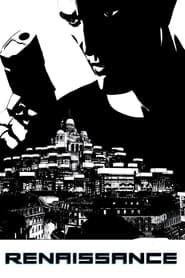Movielogr
Renaissance (2006)
Directed by Christian Volckman
Twitter Facebook Google+Most recently watched by sleestakk, sensoria
Overview
To find Ilona and unlock the secrets of her disappearance, Karas must plunge deep into the parallel worlds of corporate espionage, organized crime and genetic research - where the truth imprisons whoever finds it first and miracles can be bought but at a great price.
Rated R | Length 105 minutes
Actors
Patrick Floersheim | Virginie Mery | Laura Blanc | Gabriel Le Doze | Marc Cassot | Bruno Choël | Jérôme Pauwels | Marc Alfos | Chris Bearne | Robert Dauney | Clémentine Baert | Julian Nest | Sean Pertwee | Pax Baldwin | Jim Adhi Limas | Daniel Lafourcade | Patrick Gosselin | Yumi Fujimori | Annie Milon | Boris Rehlinger | Franck Soumah | Isabelle Van Waes | Marco Lorenzini | Crystal Shepherd-Cross
Viewing History (seen 1 time)
| Date Viewed | Device | Format | Source | Rating |
|---|---|---|---|---|
| 07/30/2007 | TV | DVD | Owned | 2.5 stars |
| (Average) 2.5 stars |
Viewing Notes
This originally appeared as a DVD review for PopSyndicate.com in 2007.
Dick would like it, Disney wouldn’t.
Animation is coming to a crossroads because, for all intents and purposes on the big screen, 2-D films are dead, with the last being Disney’s abortion Home on the Range. Pixar introduced us to the 3-D CG world, taking all the physically exaggerated hallmarks of traditional animation and fluffing it out, but still leaving it very much in the realm of that familiar world. French animation studio Attitude is ready to do something different.
It’s 2054 and Paris is guided by the Avalon Corporation, a company with a Google face and a Haliburton underbelly. Captain Karas (voiced by Daniel Craig) is the head of Section K, a division of the European Union’s law enforcement squad that specializes in kidnappings. Karas is a troubled man, having been kidnapped himself along with his brother when he was a child. After a young genetics researcher for Avalon is kidnapped, Karas dives headlong into finding her, throwing away his career in the process. However, he quickly discovers that a company looking for cures to genetic diseases is actually looking for much more at a high price.
In more recent years, Polar Express, A Scanner Darkly and Renaissance all decided to go a different direction than traditional animation: make it as realistic as possible, and therein lies the problem. Whereas the former two both used a technique called rotoscoping to produce disturbing results, Renaissance stayed away from it. Instead, the studio used motion capture, like Gollum in the Lord of the Rings trilogy or the big monkey from Peter Jackson’s King Kong. Where rotoscoped films feel stiff and inhuman, for some reason motion capture film looks less robotic and yet, it still feels very inhuman.
The problem with all three films lies in the differences between traditional animation and this style. This new breed of animated films is too real. Think about the difference between a cartoon like Betty Boop and Polar Express. The Boop characters ere designed exaggerated and fall in line with their exaggerated colors, surroundings and actions, where the Polar characters were designed to look ultra-realistic in unreal situations. Scanner’s problem was that it looked unstable and maybe too colorful, given its constantly shifting outlines.
Renaissance adds another layer to those problems by stripping away all color and shades of gray; ninety-nine percent of the film is stark black and white. The resulting formula is realistic character design and movement with no color or shades of gray to provide texture. Ultimately this leaves the characters flat and uninteresting and most of them are indistinguishable from other characters unless they have exaggerated characteristics, a classic animation hallmark. These exaggerated characteristics, like huge heads or peculiar hair, allow your brain to pick them out in an instant. Most Renaissance characters just look normal. The result is animated confusion.
On a script level, the film is good but not spectacular. It’s clear from the opening moments that the writers were writing with a Phillip K. Dick mindset, with its overarching, obtrusive themes and the thought that technology can help, but if pushed too far even the best intentions will destroy lives. However, things go unexplained and sometimes barely hinted at. This isn’t helped by the lacking visuals, which can sometimes help explain a point and the sometimes jumpy editing.
The cast, both vocal and motion, are to be commended. To be fair, neither cast has to do the other’s job and neither one has to provide true facial expressions. However, they work together quite well and the result is what the animation studio intended: realism.
The DVD is fairly bare bones, with a making-of documentary as its only special feature. The documentary describes how the project got its start at Attitude and even confirms an intentional lack of grays, but that choice is never really explained. It’s run-of-the-mill.
This new style is still early in its lifespan, but if the animation industry is going to continue down this path, things must change for successful films to be produced. Either the script will have to be spectacular to overcome the animation or the animation style will have to change to be more traditional like moments of Renaissance are. Studios need to look more to Skyland, another French project airing on Nick Toons that blends realistic animation with a traditional style and great scripts for an exceptional result. If this current trend is going to be the status quo, then it’s time to bury my head in the sand and dig out my copy of Iron Giant.

No comments yet. Log in and be the first!